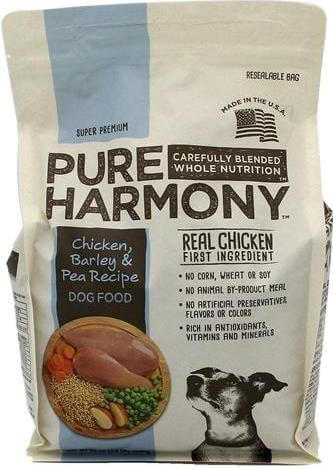
DogFoodAdvisor is reader supported See how
All reviews are 100% impartial but if you buy using links on this page, we may earn a referral fee.
Our Verdict
Latest Rating May Not Be Current
Unable to Locate Complete Label
Data on Company Website1
Pure Harmony Dog Food receives the Advisor’s second-highest tier rating of 4 stars.
The Pure Harmony product line includes the 4 dry dog foods listed below.
Each recipe includes its AAFCO nutrient profile: Growth (puppy), Maintenance (adult), All Life Stages, Supplemental or Unspecified.
| Product line | Rating | AAFCO |
|---|---|---|
| Pure Harmony Chicken, Barley and Pea | N/R | A |
| Pure Harmony Beef and Brown Rice | 3.5 | A |
| Pure Harmony Grain Free Lamb, Pea and Chickpea | N/R | A |
| Pure Harmony Grain Free Salmon, Pea and Chickpea | 4.5 | A |
Recipe and Label Analysis
Pure Harmony Chicken, Barley and Pea was selected to represent the other products in the line for this review.
Pure Harmony Chicken, Barley and Pea
Estimated Dry Matter Nutrient Content
Protein
Fat
CarbsCarbohydrates
Chicken, chicken meal, oats, barley, peas, brown rice, natural flavor, chicken fat (preserved with mixed tocopherols), flaxseed, dehydrated alfalfa meal, potassium chloride, dicalcium phosphate, tomato pomace, sweet potatoes, dried apples, dried blueberries, carrots, garlic powder, chicory root, taurine, yeast culture, minerals (zinc proteinate, iron proteinate, copper proteinate, manganese proteinate, cobalt proteinate, sodium selenite) vitamins (choline chloride, vitamin A supplement, vitamin D3 supplement, vitamin E supplement, niacin, d-calcium pantothenate, pyridoxine hydrochloride (source of vitamin B6), thiamine mononitrate, riboflavin supplement, folic acid, vitamin B12 supplement), Lactobacillus casei fermentation product dehydrated , Lactobacillus acidophilus fermentation product dehydrated, Bifidobacterium thermophilum fermentation product dehydrated, Entercoccus faecium fermentation product dehydrated, rosemary extract
Fiber (estimated dry matter content) = 6%
Red denotes any controversial items
| Estimated Nutrient Content | |||
|---|---|---|---|
| Method | Protein | Fat | Carbs |
| Guaranteed Analysis | 24% | 12% | NA |
| Dry Matter Basis | 27% | 13% | 52% |
| Calorie Weighted Basis | 24% | 29% | 47% |
Ingredients Analysis
The first ingredient in this dog food is chicken. Although it is a quality item, raw chicken contains up to 73% water. After cooking, most of that moisture is lost, reducing the meat content to just a fraction of its original weight.
After processing, this item would probably account for a smaller part of the total content of the finished product.
The second ingredient is chicken meal. Chicken meal is considered a meat concentrate and contains nearly 300% more protein than fresh chicken.
The third ingredient includes oats. Oats are rich in B-vitamins, minerals and dietary fiber.
The fourth ingredient is barley. Barley is a starchy carbohydrate supplying fiber and other healthy nutrients. However, aside from its energy content, this cereal grain is of only modest nutritional value to a dog.
The fifth ingredient includes peas. Peas are a quality source of carbohydrates. And like all legumes, they’re rich in natural fiber.
However, peas contain about 25% protein, a factor that must be considered when judging the meat content of this dog food.
The sixth ingredient is brown rice, a complex carbohydrate that (once cooked) can be fairly easy to digest. However, aside from its natural energy content, rice is of only modest nutritional value to a dog.
After the natural flavor, we find chicken fat. Chicken fat is obtained from rendering chicken, a process similar to making soup in which the fat itself is skimmed from the surface of the liquid.
Chicken fat is high in linoleic acid, an omega-6 fatty acid essential for life. Although it doesn’t sound very appetizing, chicken fat is actually a quality ingredient.
The ninth ingredient is flaxseed, one of the best plant sources of healthy omega-3 fatty acids. Provided they’ve first been ground into a meal, flax seeds are also rich in soluble fiber.
However, flaxseed contains about 19% protein, a factor that must be considered when judging the actual meat content of this dog food.
From here, the list goes on to include a number of other items.
But to be realistic, ingredients located this far down the list (other than nutritional supplements) are not likely to affect the overall rating of this product.
With 5 notable exceptions…
First, we find alfalfa meal. Although alfalfa meal is high in plant protein (about 18%) and fiber (25%), this hay-family item is more commonly associated with horse feeds.
Next, tomato pomace is a controversial ingredient, a by-product remaining after processing tomatoes into juice, soup and ketchup.
Many praise tomato pomace for its high fiber and nutrient content, while others scorn it as an inexpensive pet food filler.
Just the same, there’s probably not enough tomato pomace here to make much of a difference.
In addition, garlic can be a controversial item. Although many favor the ingredient for its claimed health benefits, garlic has been linked to Heinz body anemia in dogs.2
So, one must weigh the potential benefits of feeding garlic against its proven tendency to cause subclinical damage to the red blood cells of the animal.
Next, chicory root is rich in inulin, a starch-like compound made up of repeating units of carbohydrates and found in certain roots and tubers.
Not only is inulin a natural source of soluble dietary fiber, it’s also a prebiotic used to promote the growth of healthy bacteria in a dog’s digestive tract.
And lastly, this food contains chelated minerals, minerals that have been chemically attached to protein. This makes them easier to absorb. Chelated minerals are usually found in better dog foods.
Nutrient Analysis
Judging by its ingredients alone, Pure Harmony Dog Food looks like an above-average dry product.
The dashboard displays a dry matter protein reading of 27%, a fat level of 13% and estimated carbohydrates of about 52%.
As a group, the brand features an average protein content of 29% and a mean fat level of 16%. Together, these figures suggest a carbohydrate content of 47% for the overall product line.
And a fat-to-protein ratio of about 56%.
Near-average protein. Near-average fat. And near-average carbs when compared to a typical dry dog food.
When you consider the protein-boosting effect of the peas, flaxseed and alfalfa meal, this looks like the profile of a kibble containing a moderate amount of meat.
Pure Harmony Dog Food Recall History
The following automated list (if present) includes all dog food recalls related to Pure Harmony through April 2025.
No recalls noted.
You can view a complete list of all dog food recalls since 2009 here.
Our Rating of Pure Harmony Grain and Grain Free Dog Food
Pure Harmony contains both grain and grain-free dry dog foods using a moderate amount of named meat meals as its main source of animal protein, thus earning the brand 4 stars.
Compare Pure Harmony Dog Food
How does Pure Harmony compare with The Dog Food Advisor's most recommended brands?
Sources
A Final Word
The Dog Food Advisor does not accept money, gifts, samples or other incentives in exchange for special consideration in preparing our reviews.
However, we do receive a referral fee from online retailers (like Chewy or Amazon) and from sellers of perishable pet food when readers click over to their websites from ours. This helps cover the cost of operation of our free blog. Thanks for your support.
For more information, please visit our Disclaimer and Disclosure page.







